Lord Oxburgh on The Science and Politics of Climate Change
Khandro Thrinlay Chodon, Lay Master of Buddhism, Inspires Spiritual Retreat in Amanjiwo, near Borobodur
Gary Bencheghib of "Make a Change Bali": Beach Clean-ups Through Personal Conviction, Environmental Responsibility
Olly Steeds of Discovery Channel's Solving History Documentary Series on Conservation and Relevance of History
Captain Shane Granger on the Historical Vega Bringing Humanitarian Aid to Isolated Islanders
Hitesh Mehta on Ecolodge Principles and His New Book "Authentic Ecolodges"
President Jose Ramos-Horta on A Sustainable Future for Timor Leste
Hanne Darbol of Gangga Island Resort on Conservation and Restoration to Improve Villagers' Lives
Dr Saleemul Huq on Bangladesh as Climate Change Adaptation Model
Mike Horn: Extreme Explorer on Conservation Aboard The Pangaea Eco Yacht
Michael Switow on Fighting Poverty and its Impact on Climate Change
Benjamin Lao on Organic Pesticides and Using Sloping Agriculture Land Technology to Counter Soil Erosion
Davao, 17 September 2009. His work as a government employee didn't stop Benjamin R. Lao from pursuing his first love, which is farming. In fact, he plans to retire early to concentrate on his farm in Eman, a barangay of Bansalan, Davao del Sur.
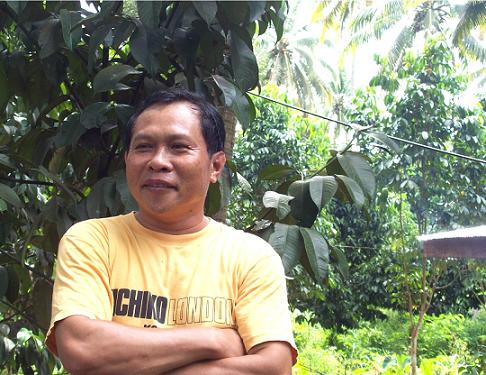
Davao's outstanding farmer, Benjamin Lao.
"My first love is farming," the Gawad Saka 2008 national awardee for coconut farming told the press corps of the Department of Agriculture Region VI. After all, his parents were both farmers and he grew up in a surrounding where people were planting rice, corn, and several other crops.
The Lao family owns about 40 hectares of land. In 1998, his mother divided the land equally among the eight children. "I am the fifth but I was unanimously chosen to assign which portion of the land should be given to each sibling," he said.
For some unknown reason, he selected the land that was so infertile that cogon grass would not even grow on it. (Aside from the five hectares he inherited from his parents, he also purchased another five hectares, which is just near his farm.)
Using Sloping Agriculture Land Technology on Barren Land
To transform the barren land into an agricultural haven, Lao started reading agricultural magazines and other publications. He also attended trainings conducted by government agencies like Department of Agriculture, Philippine Coconut Authority, and Department of Science and Technology. "I have to learn all the basics," he said.
Since the Mindanao Baptist Rural Life Center (MBRLC) is just located in an adjacent barangay, Lao decided to visit the place. "I was impressed by the way they conserve the soil and the farming systems they have developed through the years," he said.
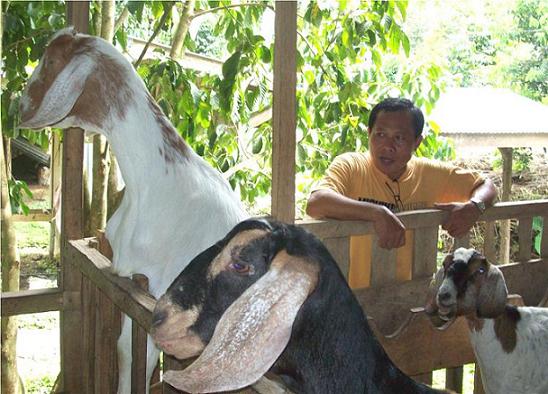
Goat manure fertilizes his nitrogen-fixing bacteria plants.
He immediately attended some of the training the MBRLC carried out and tried to adopt the techniques in his own farm. Since he was already a government employee at that time, he had to travel about two hours from Davao City to his farm during weekends just to supervise the innovations he had learned.
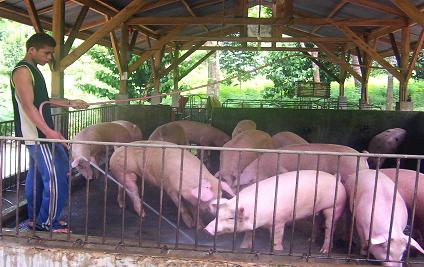
Goats and pigs provide an income stream for the farm.
The first he developed was the hilly portion. "I had to protect the soil from erosion," he said. With the knowledge he gained from the MBRLC through the Sloping Agricultural Land Technology (SALT), a soil conservation technique, he planted the area with various nitrogen-fixing hedgerows like Flemingia macrophylla, Desmodium rensonii, and Indigofera anil, which are good sources of fertilizer since these are legumes. Later on, he planted them all over his farm.
Today, he uses the hedgerows as additional feed for his goats. "Legumes contain as high as 16% crude protein and therefore provides good nourishment for my goats," he bared.
Organic Farming
Since Lao wanted to practice the principle of organic farming, he thought of adding goats.
In the beginning, he had only seven goats and the animal manure was used as organic fertilizer. But he found out there was money in goats, so he opted to increase the number. Today, he has about 170 goats in his farm. "Buyers just come to my farm and select the goats they want to buy," he said.
Goats are also good sources of milk. The milk he gets from the goats are used as an ingredient for their homemade Donna Belle durian ice cream. The extra milk are sold either as ice candy or as fresh milk at the market outlet in the town proper, about ten kilometers away from the farm.
Lao also raises pigs in his farm – about 32 heads. "They are good source of income for my family," he said. He uses the manure as source of methane gas and organic fertilizer. "We save money since we are no longer buying LPG and firewood to cook our food and products."
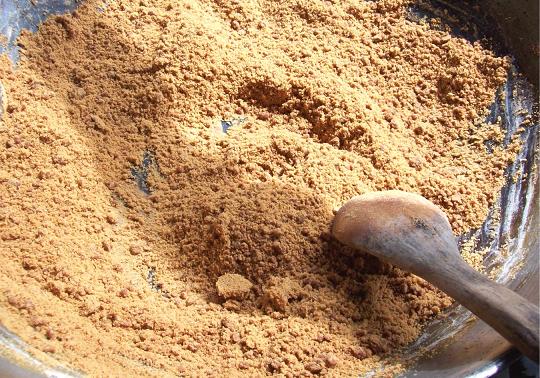
Sugar from coconut has a low glycemic index.
When he inherited the five-hectare farm, there were already coconut trees growing. Every three months, he harvests 400-600 coconuts. But several months after he planted the nitrogen-fixing legumes, the coconut yield markedly increased to 15,000 nuts per quarter.
Aside from the revenue he gets from copra, he also ventures into a value-adding enterprise right in his farm by producing coconut sugar and coconut honey out of the coconut sap or toddy gathered from his coconut trees. "These coco products have low glycemic index, a measurement of blood sugar, thus good for diabetics and those having prostate problems," he said. "It has also glumatic acid, the same ingredient present in Viagra."
Currently, he is selling his coco products at the town outlet, in the cities of Digos, General Santos, Butuan, and Metro Manila. "Demands for our products are continuously increasing," he said.
Zero chemical pesticides
On value adding, Lao pointed out, "(It) is an important component in a farming system. For instance, if you have goats, you must know how to produce fresh milk and having other saleable products from the animals. In the case of coconut, don't think only of copra because when it is cheaper, you can always have another product to sell."
Aside from coconut, the farm is also teeming with various fruits like lanzones (more than a thousand trees), durian (700 trees), mangosteen, and rambutan. "I bought them one at a time from my salary as a government employee," he said.
In his farm, you won't see his farm workers using chemical pesticides. "I had a tragic experience with chemical pesticides when I was still a teenager while cultivating rice in our farm located at the neighbouring barangay," he revealed.
Instead, he recommends using Eman, which stands for "epektibo, mura, at natural" (effective, cheap, and natural). "This is a concoction composed of fresh goats' manure, kakawate, makabuhay, and hot pepper," he informed. "These are soaked together for 48 hours and after that the mixture is ready for application."
According to him, the mixture is effective in repelling plant pests and diseases. In addition, it is also a good course of foliar fertilizer. "We are committed to help preserve our environment. We want to teach Filipino farmers the right way of farming through natural method and that is by not using commercial fertilizer or pesticides," he said.
To people who have been to his farm, they have described it as a haven. You don't see only livestock and crops but ornamentals as well. "It's nice to see beautiful flowers underneath the trees," he explained. "Also, the flowers serve as breeding areas for beneficial insects like spiders and dragonflies."
Davao's Outstanding Farmer
In 2005, Lao was chosen as the most outstanding farmer of Davao del Sur. The following year, he was recognized by the Philippine Council for Agriculture, Forestry and Natural Resources Research and Development as a Magsasakang Siyentista (scientific farmer). Last year, the Department of Agriculture bestowed the honor as one of the country's outstanding farmers. "It was far beyond my expectation," he said of the recent award he received.
Visit Benjamin R Lao's website here or contact him.

Apart from vegetables and trees that earn him money from the prouce, Lao also plants ornamentals to cultivate butterflies and spiders which he considers beneficial to his farm.
Sebastien Marot of Friends International on Rescuing Streetkids and Creating Green Enterprises
Dr Thomas Goreau on Coral Reef and Fisheries Habitat Restoration
Prof Gatze Lettinga on Social Security For All Through Clean Water Treatment
John Kaizan Neptune on Bamboo Magic at Miri International Jazz Festival
Randy Raine-Reusch on Rainforest World Music Festival 2009
Sarawak’s pride and music lovers’ delight – the Rainforest World Music Festival – is going to tingle with rare sounds and sensations, as Malika Naguran finds out from her interview with the show’s Artistic Director Randy Raine-Reusch.
Randy, what are some of the more unusual sounds or experiences that we can expect from this year’s Rainforest World Music Festival? You went at great lengths to source Inti Illimani for instance.

This year I have been fortunate to be able to invite some of the top representative artists from Chile, Hungary, China, New Zealand and Tanzania! This is a year of outstanding musicians. Inti-Illimani and Muzsikas are World Music legends with careers that span three decades and have huge international reputations. I am very excited to have artists of such stature to be performing at our festival.
Red Chamber has two of China's top performers in the group and you can't get any better than this! The Zawose family are famous for travelling the world with their now deceased World Music legend Hukwe Zawose. They are simply amazing and unlike any African band that has ever graced this stage. They will simply blow people's minds!
What are some quaint or endearing traditional musical instruments that the audience can enjoy watching being played, and listening to?
Well there are quite a few this year. The jouhikko is the feature instrument of Jouhiorkesteri. It is a small rectangular bowed lyre where the fingers actually fit through the body of the instrument to finger it. It is an instrument that you see in medieval paintings and the members of Jouhiorkesteri have been responsible for its revival.
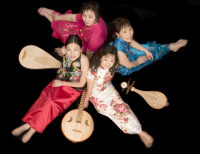
Red Chamber - from Tang dynasty to jazz.
Muzikas will bring a gardon, an instrument that looks like a rough-hewn cello, but it is hit with a big stick as a percussive instrument, its really bizarre and amazing.
Moana & the Tribe will bring some very rare Maori instruments that are seldom seen. St Nicolas Okiestra (there are a few versions of this name depending on the language) will bring some traditional Polish instruments that we have never seen before as well. The list goes on...
You’ve played, I suppose, more than a hundred musical instruments and can be biased towards certain sounds that you personally enjoy. Are you on the lookout for something unique each time with the bands that you select?
Actually I have a collection of 700! I am not biased towards any one instrument, except I always want at least one traditional instrument in each group. I am always on the lookout for something that has not been here and will provide the audience with a new and exciting experience. I want this festival to always have some surprises.
What is your criteria for selecting the bands?
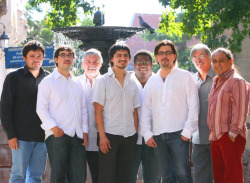
Inti-Illimani from Chile brings 4 decades of Latin American music.
I look for excellent musicianship, I always want a traditional instrument included, I want the band to be excited to be coming to Malaysia and Borneo in particular, I look for bands that really want to share their music and culture, while learning about the cultures in Sarawak and surrounds.
I look for bands that have not been here before, but when I bring a band back it is because I feel that it has something more to give to our audience. I look for styles of music or countries that have not been represented yet, but also styles that the audience really likes and wants more of.
I also look for a blend of impact, so that more acoustic groups perform early in the evening and appropriate for families, and louder more electric bands perform later in the evening for those that want to dance. I am trying to find more indigenous groups for future festivals, as there is a magic and purity in their performances that has been lost in other music.
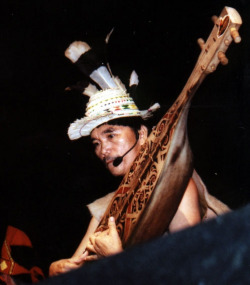
Sarawakan Lan-E-Tuyang.
That is why I have brought the best sape players in Sarawak back this year, as their music is pure gold. Maybe local people may not appreciate it, but ask any of the other musicians once they hear it and they will tell you how special it is! I must say that I do shy away from music that I think might offend the sensibilities of my audience, but this just seems to lead me towards more sophisticated choices.
According to the lineup of performers, the range of the sounds is wide and exciting. Moana & The Tribe on the Maori tradition sounds more spiritual than world. But that can be argued. What is your definition of World Music? After having served as Festival Director for 12 years, has that definition changed?
Actually my definition for World Music has not changed; it was in long form "Music of, or stemming from a traditional culture." However I have been more often quoted in the short form "Local music, not from here", of course in Sarawak's case it is from here.
Music and spirituality have been mixed in every culture of the world, and many musicians look upon their music as their own form of spirituality, so the case of Maona still fits the definition. Oudaden also has that element but from an Arabic perspective. The world is vast and there are so many styles of music that our audience has not heard yet, and I hope to bring a lot of it!
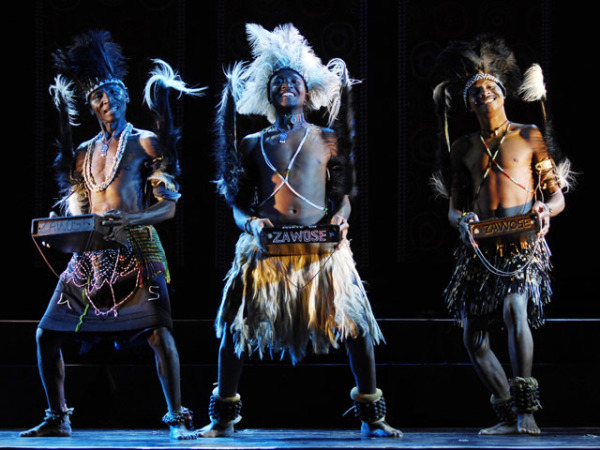
Zawose Family Africa from Tanzania carries the legend of Hukwe Zawose.
Randy's photograph taken by Imran Ahmad of Escape Inc. The rest courtesy of organisers Sarawak Tourism Board.
This year, the performers that will dazzle the crowds three nights running from 10-12 July are: Inti-Illimani (Latin America), Red Chamber (Canada/China), Akasha (Malaysia), Poum TChack (France), Lan-E-Tuyang (Sarawak), Zawose Family Africa (Tanzania), Noreummachi (Korea), Maona & The Tribe (New Zealand), Jouhiorkesteri (Finland), Muzsikas (Hungary), Jeff & The Vida Bluegrass Band (US), Dazkarieh (Portugal), Oudaden (Morocco), Asika (Malaysia), Sekaa Jaya Jenggala(Bali), The St.Nicholas Orchestra (Poland).
Also featuring Rainforest World Crafts Bazaar. Be there, or be very left out!
Rainforest World Music Festival is on July 10th-12th, 2009 at the Sarawak Cultural Village.
Tickets online: www.ticketcharge.com.my
Max Ammer and Community-based Tourism at Papua Diving, Raja Ampat
By Mallika Naguran
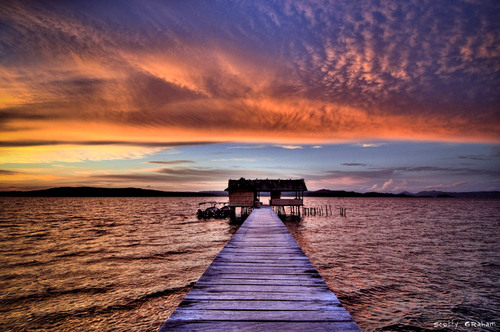
Another dazzling sunset at Kri pier when the day sighs to a close.
West Papua, 28 March 2009. Being eco can mean a number of things to different people; the first thing that springs to mind for most is the preservation of nature. For Max Ammer, a pioneer dive operator in Raja Ampat and owner of Kri Eco Resort and Sorido Bay Resort at Papua, Indonesia, people are at the heart of any ecology-related business.
“Eco to me means working with the local people to build a better future,” he tells over dinner. A gecko emerges from behind the ketchup bottles, approaching us cautiously on the wooden table. I wonder if I should remove my hand that’s resting in its path – I do love animals, but I don’t fancy my body becoming part of their habitat.
Max extends his hand out to the gecko to crawl on. “You know when I built this place 15 years ago, I didn’t have to specially rear these wild things. They just appeared – we have monitor lizards, ducks and birds just roaming around.”
Every night, following dinner, the guests gaze at the juvenile bamboo sharks wading in the shallows just below the dining lounge on stilts. In the morning, we are awakened by hysterical cackles from endemic birds such as eclectis parrots, brush turkeys, sulphur crested cockatoos and hornbills. No need for alarm clocks here.
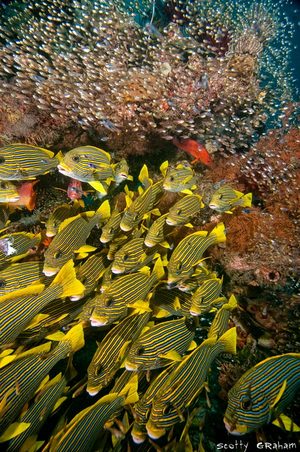
The omnipresent sweetlips.
At breakfast, we are startled to see a pair of coconut crabs huddled around a bamboo pylon at the lounge ceiling. Hideous as they are, they are also harmless and rather immobile; apparently they lie on coconut trees and love cracking the solid nuts with their rock-hard pincers. I sat a respectable distance away from them.
The guest rooms at Kri Eco Resort are also perched above the waters, so a daily sight would be numerous fish species flitting around the pylons, seeking shelter from sea currents or storms. Baby barracudas pursue parrotfish of amazing variety, tagged along by turtles.
Little of the coral reefs at Cape Kri (house reef) is destroyed with the building of Kri Eco Resort, including the jetty that Max’ father helped to build, aided by local talent and muscle. One such talent couldn’t measure straight, resulting in the construction of a not so perfect wooden platform that scuba divers walk on to get to the dive equipment center at the end of the jetty and to hop on to the dive boats.
Everything about Kri Eco Resort is handmade: the Sunset Lounge and its lazy deck chairs, the bamboo chalets, the coconut leaf and nut wall finishing and décor. Even the bricks are made by hand by the senior folks, whom Max employs, with the job title of “All Rounders”.
“I want local people to make the money,” says Max, who reveals that he could have built the resorts (including the higher-end Sorido Resort) and run the operations quicker with more experienced staff from other parts of Indonesia. In fact the dive crew are all Papuans, a number of them barely made it through school.
But Max is committed to Raja Ampat’s people in more ways that one, and its not always for business. He builds local talent and skills in this remote region of Indonesia spanning from tourism-related ventures to trades for livelihood to careers in scuba diving.
Mad Max
Max landed on Pulau Kri, part of Raja Ampat in 1992 on a motorized rubber boat. He found himself in the heart of darkness, away from civilization, close to indigenous Papuans who are warm, dark and beautiful, and this suited him fine. It reminded him of his growing up days in Nigeria though born in Holland.
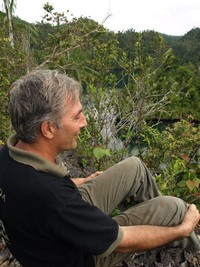
Max Ammer explores Papuan islands.
He had in the last few years explored the area for World War Two wrecks, specially commissioned by the US aviation authorities, and found quite a few aircrafts buried in silt.
Aircraft, after motorbikes, is Max’ passion. He had fiddled as an aircraft mechanic for a few years before flying one finally and is fixated with all things that fly (and more so if they crash).
Retrofitting classic Harleys as a youth, Max’ building streak has led him to design the two resorts on Kri island – based on sketching on paper – and a load of islanders to saw things and nail them together. A pinch of inspiration and a chunk of madness is all that it took to get Max Ammer going into building an eco-led business in the unknown territory of Papua.
Conservation of Raja Ampat
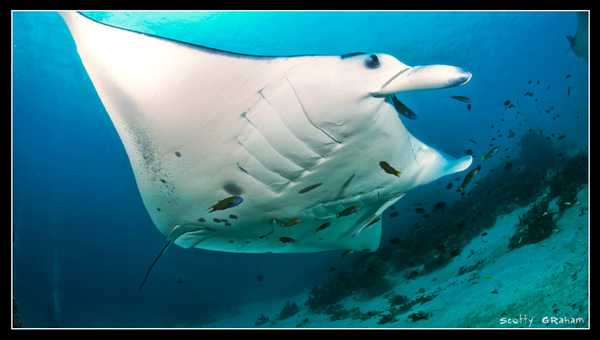
You can lose yourself swimming with the mantas here.
The pristine reefs of Raja Ampat and the plentiful marine species were under threat with destructive fishing practices such as bomb fishing and deep-sea trawlers. The big fish started to dwindle. Logging and mining on the islands impacted the waters with pollution.
Max knew he had to do something to stop the destruction and pollution. Raja Ampat needed protection, or better, conservation, or risk losing its intrinsic beauty and biodiversity. It was a stroke of luck when Dr Gerald Allen, renowned marine scientist and author, ventured into this path. Dr Allen was impressed with the numerous species of freshwater fishes found here, and the pristine state of corals. In two single dives, he recorded the highest count of fish species: 283 species at at Cape Kri and 281 at South Fam group. A benchmark for an excellent fish count is 200.
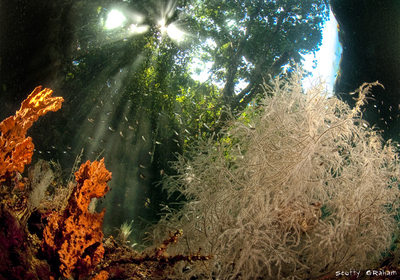
The Passage is a highlight in Papua diving.
A consultant with Conservation International (CI), Dr Allen canvassed for Papua to be considered in the organisation’s conservation programme, and after three years, in 2001, it happened. Plans for a marine park were drawn; by mid-2007, the Raja Ampat Marine Park was formally declared.
When I visited Kri Eco Resort in March 2009, I found out that the zonation and management plans were still under development, however, an important regulatory mechanism had already kicked in: the Raja Ampat Tourism Entrance Fee of Rp500,000 that involves the issue of an annual waterproof plastic entrance tag.
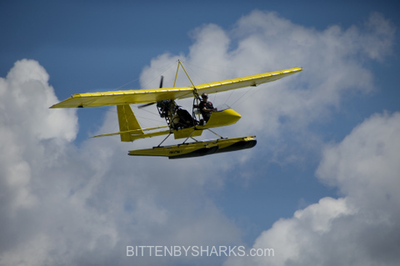
Max' passion to preserve Papua soars high.
Part of the fee goes to community development, conservation and enforcement, covering marine areas and land-based activities such as logging and mining. In 2007 and 2008, priority was given to the “Posyandu” system, which is a healthcare provision for mothers and children. Something that’s also close to Max’ heart: in the early days, he had improved the water wells in Raja Ampat with chlorination and safety measures and created 13 new wells for the people.
Conservation at Raja Ampat now is taking on new heights with an aerial monitoring programme sponsored by CI and other NGOs. This involves a light aircraft surveillance to keep an eye on illegal activities on water and land. And the pilot keeping vigil behind the wheels is no other than Max Ammer himself.
People Welfare and Development
Nikson Soor born in Batanta, Raja Ampat, is just one example of how a Papuan is groomed to become an asset in Raja Ampat tourism industry. This amiable and energetic Papuan dive master is a manager at Papua Diving with over 11,000 dives logged.
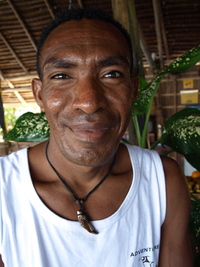
Nikson now protects turtles and more.
Nikson tells me that he first met Max when he was a wee boy, selling turtles that he had just caught with his fisherman father. Max bought those turtles from him and promptly released them. Nikson couldn’t understand this white man’s actions, but soon learnt the beauty and fragility of marine life.
“He just put a tank on me and took me down,” grins Nikson, who added, “and my eyes opened wide looking at the underwater life.” Nikson, who was just 14 then, was instantly converted.
It is the start of a long and deep friendship between the two; Nickson who is 34 years old, and Max, 47. Today, Nikson is not just a top dive guide sought after in Raja Ampat, he is also an environment advocate, concerned with pollution and illegal fishing. “I will teach Nikson how to fly even,” laughed Max, who is eager to begin the aerial surveillance.
Don’t expect to see a Western dive guide or master at Papua Diving, because there isn’t one. Max believes in investing in local education and training local Papuans, a road he’s taken that’s often long and bumpy.
“They are good people and I want them to learn a new trade and to earn some income,” he said, hoping to get them out of the poverty cycle. Dive guides at Papua Diving are given proper employment contracts; they are also paid fair wages, provided with food and shelter, and given weekly day off plus regular vacation.
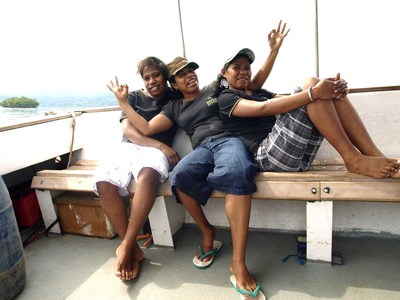
Staff on boat excursion with Max and guests on their day off.
Two kitchen help, both women, had expressed interest in becoming dive guides and today they are being trained for this career prospect. It is no wonder that there is a deep sense of belonging among the staff at Max’ resorts.
Sustainable Clam Trade
Giant clams are a delight to behold in a number of the dive sites around Raja Ampat. These, however, are taken away by local fishermen and sold as food. Clams, like fish, are an important source of nutrition for Indonesians.
Once Max had bought 10 giant clams from a fisherman for US$80, and then released them. But he realized that couldn’t keep doing that.
Max now has an idea. By introducing a clam farm, Papuans will learn how to grow clams and sell them in a sustainable fashion and will soon learn to leave the giant clams in dive sites alone.
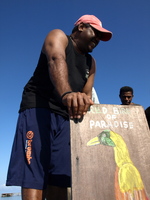
An ecology treat awaits the Papuan explorer.
Other plans afoot are homestays and kayaking adventures around the exotic mushroom islands. This augments what he has already established with the locals – bird watching tours in particular the Red Bird of Paradise. Proceeds go entirely to the villagers, who then see the value of this tourism activity and stop them from catching these birds and selling them overseas as exotic pets.
A trip to Max Ammer’s resorts is worth every dime. If you plan a trip in 2010, you may just enjoy his other service, a live aboard dive boat, one which he hopes to start designing soon - and by himself of course.
Photography by: Scotty Graham, BittenBySharks.com and Mallika Naguran. Have a chuckle reading Scotty Graham's photo blog.
Up next, destination stories on Raja Ampat and Kri Island.
More information on Kri Eco Resort, Sorido Bay Resort and Papua Diving at:
Sorong Office:
PT Papua Diving
Jalan Gunung Tidar No.1
Kampung Baru Sorong
PAPUA - 98413 Indonesia
Phone: +62 (951) 328 038
Fax: +62 (951) 328 038
info@papua-diving.com
Contact Max at max@papua-diving.com
This trip was kindly sponsored by SilkAir (from Singapore to Manado, Indonesia) and Express Air (from Manado to Sorong).
About Silkair
Singapore-based SilkAir flies one of the youngest fleets in the Asia region, with an average age of 5.5 years. It operates fifteen aircraft, nine Airbus A320-200 and six Airbus A319-100 aircraft. SilkAir positions itself as a premium, short-to-medium haul regional carrier offering unique appeal amongst leisure and business travelers in Asia. Visit www.silkair.com for more information.
In conjunction with its 20th anniversary celebrations, SilkAir recently announced the adoption of Friends-International, an award-winning Non-Governmental Organization (NGO) which focuses on reducing the number of street children across Asia and beyond, as its official charity. Sharing Friends-International’s vision to give children access to education, SilkAir will offer two children from the NGO’s vibrant Phnom Penh headquarters SilkAir Scholarships to study English at the Australian Centre for Education in the Cambodian capital.
About Express Air
The gateway to East Indonesia with daily schedule service from Jakarta to Makassar, Ternate, Sorong dan Jayapura. Its route network includes other new destinations within Papua such as Kaimana, Fak-Fak, Manokwari, Nabire, Tanah Merah, Babo etc.
Express Air has six 32 seats Dornier 328 turbo-prop, a modern advance high performance aircraft with latest technology on board to serve number of destinations along West-East Papua axis, Sulawesi, Maluku, and Nusa Tenggara.
Mark Ginsberg on Zero Energy Communities through Clean Energy Technologies
by Mallika Naguran
20 April 2009, Singapore. “You might have noticed that we have a new President,” said Mark Ginsberg as he flashed a slide of Mr Barack Obama on the screen. Laughter from the audience greeted the Board of Director with the Office of Energy Efficiency and Renewable Energy (EERE), Department of Energy, USA.
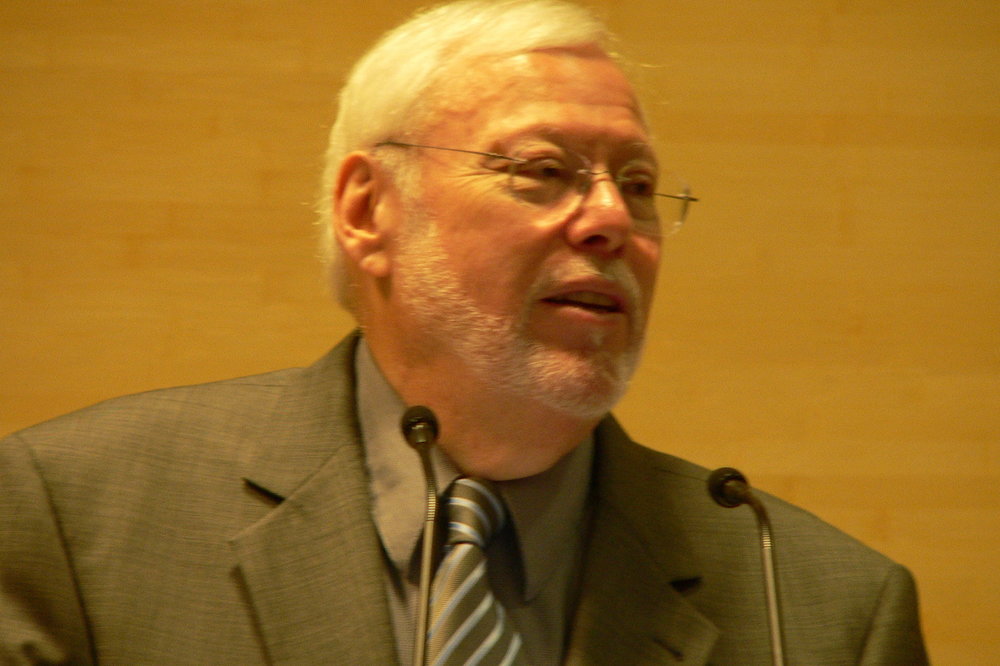
"Leapfrog into new generation technologies" - Mark Ginsberg
Mark was addressing a rapt audience in Singapore at the invitation of the Energy Studies Institute of the National University of Singapore on 16 April 2009. His mission was not just to introduce the new President’s environmental measures, but also to put forth an argument that economic prosperity can be had from the development and proliferation of clean energy technologies.
The connection between economics and energy is clear and present, and a big deal. “I’ve joked about energy efficiency being inevitable for the last 30 years. And now it finally is. Now the world leaders are talking about it in the way I could never have imagined years ago,” shared Mark. Having served in previous US Administrations, Mark described Obama’s inaugural address as “music to my ears”, in particular when the new President spoke about connecting energy to economic solutions.
The President is bent on cracking America’s oil addiction. He has announced a US$150 billion investment in energy technologies over the next 10 years that will restore the economy in the short term, and the creation of five million new jobs. In the long term, the country will see a more efficient, effective and productive economy. This sum is part of the newly announced American US$700 billion recovery and reinvestment budget.
“We got to be lean and clean in order to make it more successful in the future,” said Mark, explaining that strategies are in place to “reduce oil imports, put one million plug-in hybrids on the road that go up to 150 miles per gallon, and to ensure than 10% of our energy come from renewables by 2012, and 25% by 2025.”
Drilling down to details, the US is embarking on a slew of initiatives: double the alternative energy over the next three years, modernise 75% of federal buildings (currently there are around 500,000), and improve the energy efficiency of two million homes - particularly eligible are low-income families. “We will build solar panels, wind turbines, construct fuel efficient cars and buildings, develop clean technologies that will lead to more jobs, more savings and cleaner safer planet for us all,” said Mark.
Mark spoke more importantly of the development of new generation of technologies. “The concept of science and discovery is to invest in science to achieve transformation technologies (not just incremental) to leapfrog into the next generation,” he said. Transformational technologies will change the landscape of energy supply and demand, boost economic prosperity, create millions of green jobs and increase competitiveness. “Not only the US, but if the whole world is not competitive, it will be business as usual,” said Mark.
As part of his commitment in ramping up a new generation of technologies, President Obama had appointed Nobel Peace Prize Winner and Head of National Laboratory Dr Steven Chu, the new Secretary of Energy, who has since restated the Obama Administration’s energy priorities. Dr Chu, described Mark, spoke about the need to pursue material and cost effective measures with a sense of urgency.
“He said that we can’t wait any longer,” said Mark. So some major priorities and goals have been set such as achieving sustainable cities through zero energy buildings and communities.
Sustainable Cities
Currently half of the electricity supplies of the US come from coal, 20% from nuclear, and only a few percent from renewable sources. With coal as a cheap source, the switch to alternative energy supplies is going to be slow but sure.
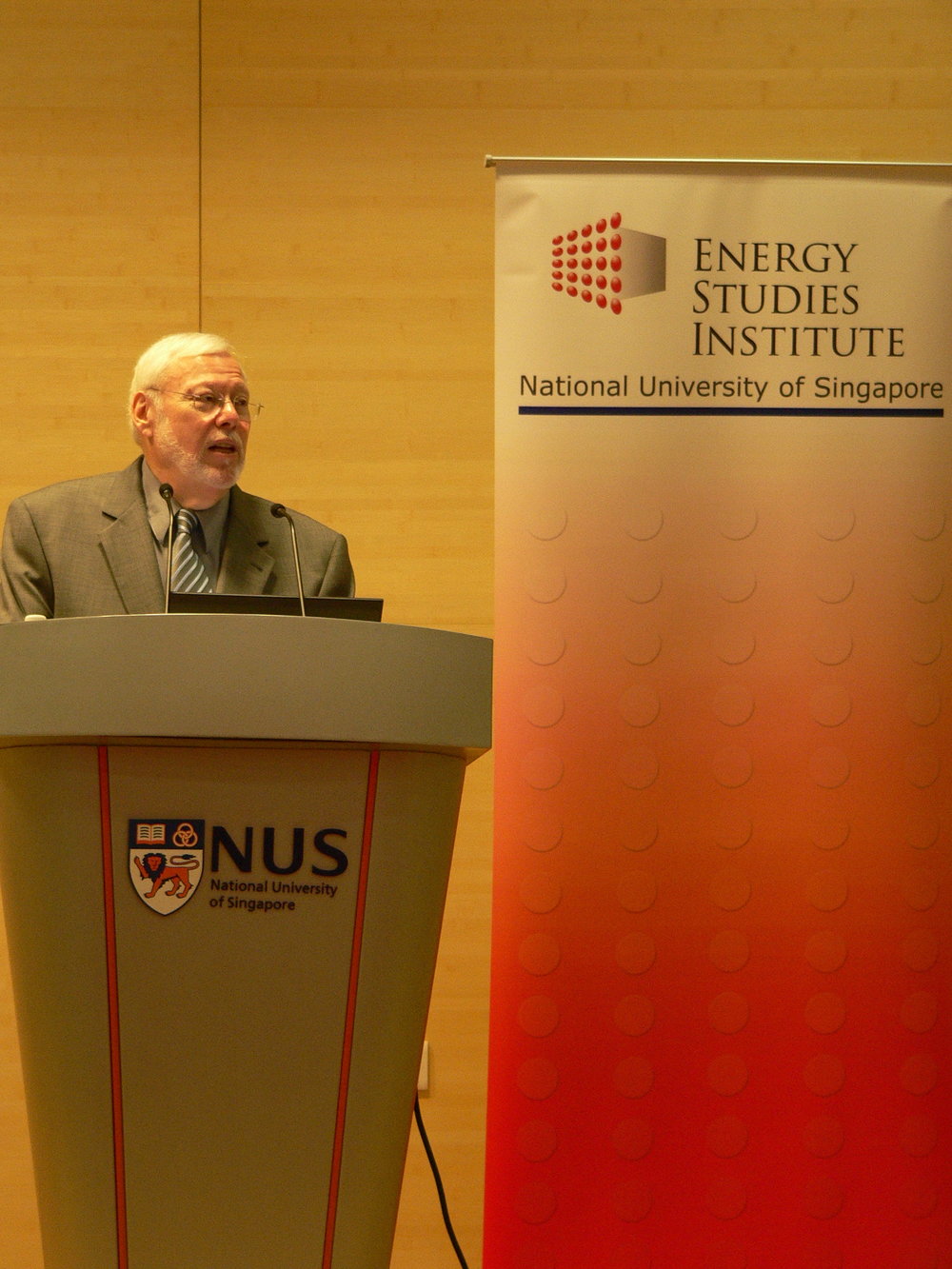
Waste is an enemy.
Strategies to achieve sustainable cities thus include increasing supplies of alternative energy sources and advancing technologies that lead to zero energy communities. “I am optimistic about solar energy,” said Mark. “Solar water heating is cost effective; concentrating solar has great applications and photovoltaic solar can be attached to buildings in a way that can make buildings power plants.”
Mark described how the head of MIT had told President Obama when he was visiting the institution about its research projects: microdots on windows to harness solar power (a nano capability), advanced battery and storage and non-food biofuel generation. Wind turbines, said Mark, are improving with lightweight materials harnessing greater wind from lower speeds, and he is hopeful: 20% of energy sources would come from wind, he opined, up from few percentages now.
Other promising technologies that will change the shape of things are geothermals and nanotechnology. “There are over a million geothermal heat pumps in the US. My interest is ground source heat pumps for buildings. They are cost effective and environmentally sound,” said Mark.
As for biofuels, Mark stressed that the US government is committed to next generation non-food biofuels. “We do not want to compete with food,” he said, adding that there are existing farmlands in the US and Europe that can be used for energy crops.
In the US, corn is a major part of its ethanol product. In terms of phasing out corn-based ethanol, it will take a while. “Historically, mid-western farmers produced ethanol for their trucks on their farm and they produced a little more and sold it,” explained Mark. Even with the progress with alternative energy sources, Mark suspects that in the future, there will still be some corn-based ethanol in the US “as it’s one of the feedstock”. He added, “I don’t know if they’ll be able to make that conversion to the stalk and not the corn, as energy content (of the stalk) is less, so the economics will begin to make the change.”
Economics will change with technological breakthroughs. “We’re working like crazy to invest in nonfood second generation cellulosic fuels. Our idea is to take a variety of feedstock from different plants, find the best energy sources from those plants, explore conversion processes (chemical or thermal) that can be the most effective ways of utilizing the energy in each of the different plants.”
Human genome technology is also being employed in research, revealed Mark, so that plants can produce energy. Mark then shared what the US Administration has in mind to reduce demands. For one, there is the Save Energy Now programme for industrial assessments and tools to save energy resource at the workplace. In the US, buildings guzzle 40% of energy consumption. This figure is set to grow if nothing is being done.
Mark, however, spoke about arresting this by optimizing system components and work toward zero energy building and communities. Firstly, there are down-to-earth tools in place to help buildings operate more efficiently such as energy labeling schemes like Energy Plus, Consumer Star, and standards set by the US Green Building Council.
Then, of course, there’s science fiction. “We are working towards buildings becoming power plants,” said Mark. He spoke about new generation of sophisticated controls as the key part of moving towards smart grid, beyond smart buildings. “From power plants to refrigerator that have controls that can send electrons to the right place at the right time at the right price; and that can optimize the performance of the electric grid – this is big part of President’s investment strategy,” said Mark.
“We are moving towards zero energy buildings; buildings that are so energy efficient that produce their own power through photovoltaic cells or heat pumps that over the course of the year, they produce as much energy as they require,” he said. Mark shared how he faced laughter and derision 15 years ago when he talked about zero energy buildings; now he sees this being developed as a study by the International Energy Agency, and a special project by the Asian Energy Partnership. Mark served as Director of the Arizona Energy Office before joining the Department of Energy in 1991.
“The research goal at US EERE is that (we are confident) with the advancements in energy efficiency technology of renewable technologies, we can achieve cost effectiveness in a building; so that a typical building in 2025 will cost the same as a zero energy building. With the new investment that the President is making, we think we can move that date up substantially.”
In Zero Energy Communities, everything is a resource and nothing is waste. For example, buildings that serve as power plants, and municipal waste that goes into local bio-refinery for transportation fuel instead of landfills.
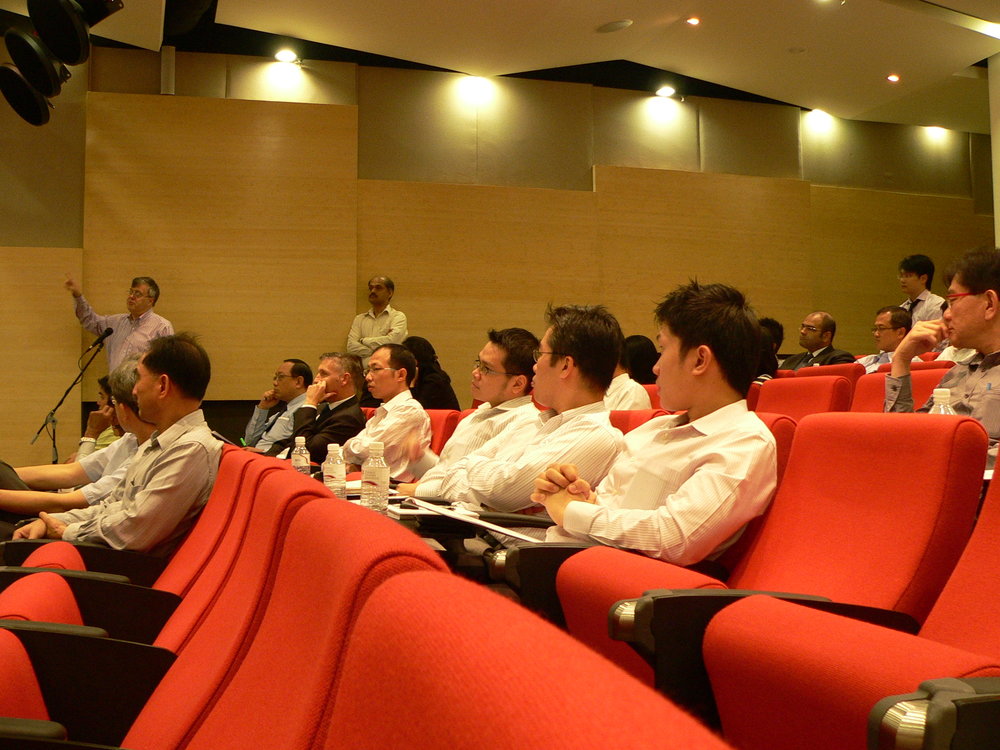
Ideas, not oil addicts at the Energy Studies Institute.
“Waste is our enemy and we need to overcome some of that,” said Mark.
Mark is optimistic about the future because of new emerging technologies. These, he said, can break through the problems of the past, and genuinely apply for current solutions.
Photos by Mallika Naguran.
Useful Sites:
Energy Studies Institute www.esi.nus.edu.sg
Office of Energy Efficiency and Renewable Energy www.eere.energy.gov
Alliance to Save Energy www.ase.org
Building technologies programme www.highperformancebuildings.gov
US Green Building Council www.usgbc.org
Promoting an Energy Efficent Public Sector www.pepsonline.org




